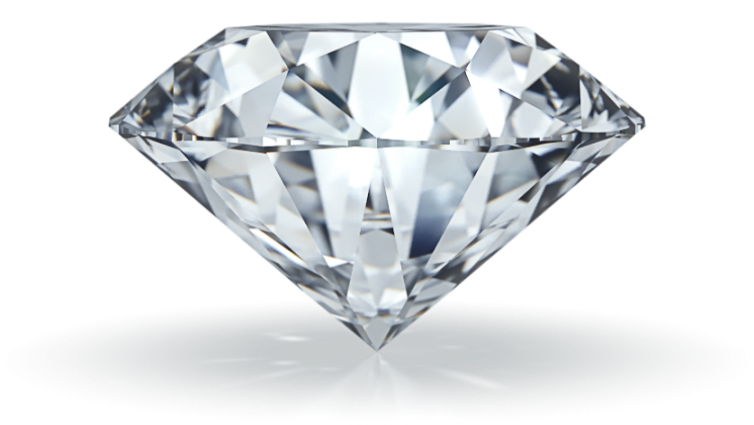April Birthstone - Diamond

April, you’re the month when the warmth of spring is in the air. It’s not only joyous for this reason but who can resist the playfulness that is April Fool’s Day!
This month, around the world we also celebrate Earth Day and Buddha’s Birthday to name a few special days. However there’s one more really tremendous side to April and that is the long history and love affair we have with your birthstone…. DIAMOND!!

A BIT OF HISTORY….
Since ancient times diamonds were used to represent wealth, power and invincibility. It is believed the first diamonds were found and traded in India as far back as the fourth century. India is where the fabulous deep blue 45.52ct Hope Diamond was found.
Slowly through trade, these diamonds made their way to Western Europe and by the 1400’s many of Europe’s wealthy elite were accessorizing their clothing with these treasures.
It is around this time Mary of Burgundy received a diamond solitaire ring as a betrothal gift, and there began a new tradition.
Then in the 1700’s diamonds were found while gold miners were panning for gold. Brazil then became an essential source which lasted for 150 years producing over 16 million carats!
Moving forward to the 1800’s, 1868 to be exact. The “Eureka Diamond” was found in South Africa and sold for the sum of 500 sheep, 10 cows and a horse… Later, the purchaser renamed the diamond “Star of South Africa”, had it recut and sold it for £11,200! A huge sum for that time. Although, in South Africa diamonds were being mined since 1860, it was only as a result of this sale did great attention begin to be paid to the wealth of diamond deposits in that region.
Did you know the 60 year anniversary is also referred to as Diamond Jubilee?

HOW DURABLE IS A DIAMOND?
Diamond is the hardest gemstone measuring 10 on the Mohs scale.*** Only a diamond can cut or scratch another diamond. As a matter of fact, this is exactly how diamonds have been cut going back as early as the 16th century. Knowing this is an asset when storing your diamond jewelry. If the pieces are kept close together they should be bagged or wrapped to prevent scratching.

***This scale identifies the level of hardness of a gem ranging from the softest at 1 which is talc to 10 which is diamond.
Any gem including diamond will break if it is hit hard enough and in the right place. With natural wear and tear you may find chips along the girdle, diamonds can be quite brittle and prone to chipping.

CARE & CLEANING OF YOUR DIAMOND JEWELRY
Diamonds are pretty low maintenance, with regard to care. A bit of soapy water, a soft brush then finishing with a soft polishing cloth will keep your diamond shining!
Diamonds that become loose in a setting should be attended to immediately. Diamonds can scratch precious metals and if loose it will eventually cut or wear through the claw. Tightening a claw is much less expensive than replacing a claw.
Did you know cavemen tied cords made of braided grass around their chosen mate’s wrists, ankles and waist to put her under his spell?
WHAT EXACTLY MAKES COLOURED DIAMOND SO SPECIAL?
In diamonds, rarity equals value. With diamonds in the normal range, value is based on the lack of color, because colorless diamonds are the rarest.
With fancy color diamonds, the ones outside the normal color range are the rarest and most valuable especially colors in the pinks, blues, and greens. In all cases, even very slight color differences can have a big impact on value.

Fancy Colour Diamond (Source: GIA)
Compared to fancy yellows and browns which occur in a wide range of hues, diamonds with a noticeable hint of any other color are considerably rarer. Even if the diamond displays light hues and weak dispersion, as long as they show color in the face-up position, they qualify as fancy colors.
Red, green, and blue diamonds with medium to dark tones are extremely rare.
Did you know a large variety of healing properties have been attributed to the diamond, including the ability to cure stomachaches, memory loss, depression, physical tiredness, infections, mental illnesses and nightmares to name a few.
AND THEN COME THE IMITATIONS!
Diamonds are highly desirable and one of the most sought after gems. Now, you can guess there will always be those trying to find the perfect “look alike” for much less expense, many of which have passed as genuine diamonds. Here are two of the most popular “faux diamonds”.

CZ, Fancy Cut Diamond (Source: GIA)
Cubic Zirconia has been one of the favorites because of the low cost and great brilliance. In fact it displays much more sparkle than a diamond and when a one carat diamond and one carat cubic zirconia are compared side by side, the CZ will appear larger. This is due to how the CZ disperses light and the fact a CZ is less dense than a diamond. Over time, a CZ will begin to take on a milky appearance and the facets will dull. Definitely not a great diamond standby.
More recently, Moissanite (lab produced) has been introduced as a diamond substitute. The brilliance and durability makes this gem appear a perfect match. It is so good, when conducting a simple thermal test it will test as diamond. A bit alarming, however the good news is it usually has a slight greenish tinge and although it can scratch a sapphire, it cannot scratch a diamond. There are a few other tests gemologists can make to rule out this fake as a natural diamond…
Did you know the ancient Romans and Greeks had a lot of powerful beliefs about diamonds, including ideas that diamonds were the tears of the gods or possibly even splinters that had broken off of falling stars?
April is known as the “humor month”, and its name means “to open”. This is a month when we begin dreaming of planting our gardens, and the daunting task of spring cleaning. Don’t forget your diamonds….after all the heavy creams used over winter, they need a good spring cleaning as well!
Happy Spring!



